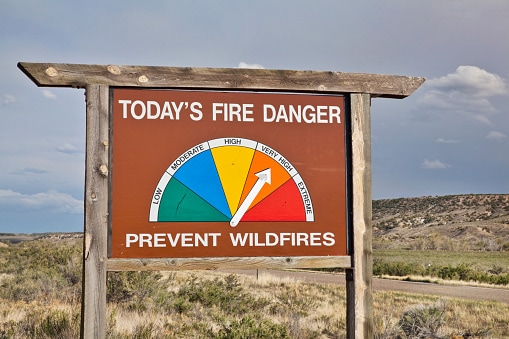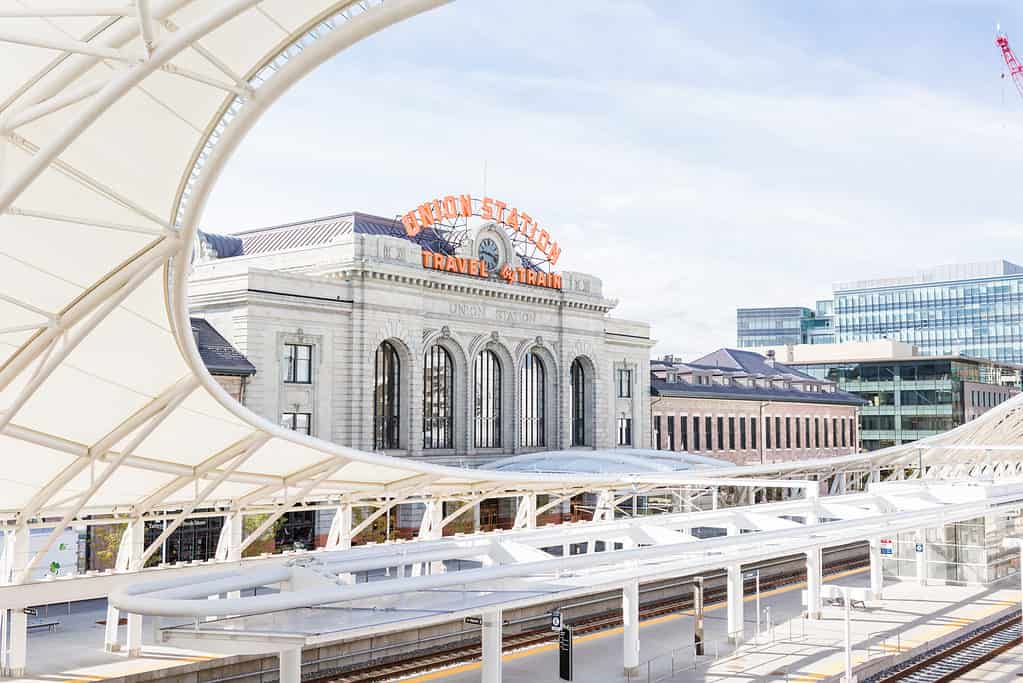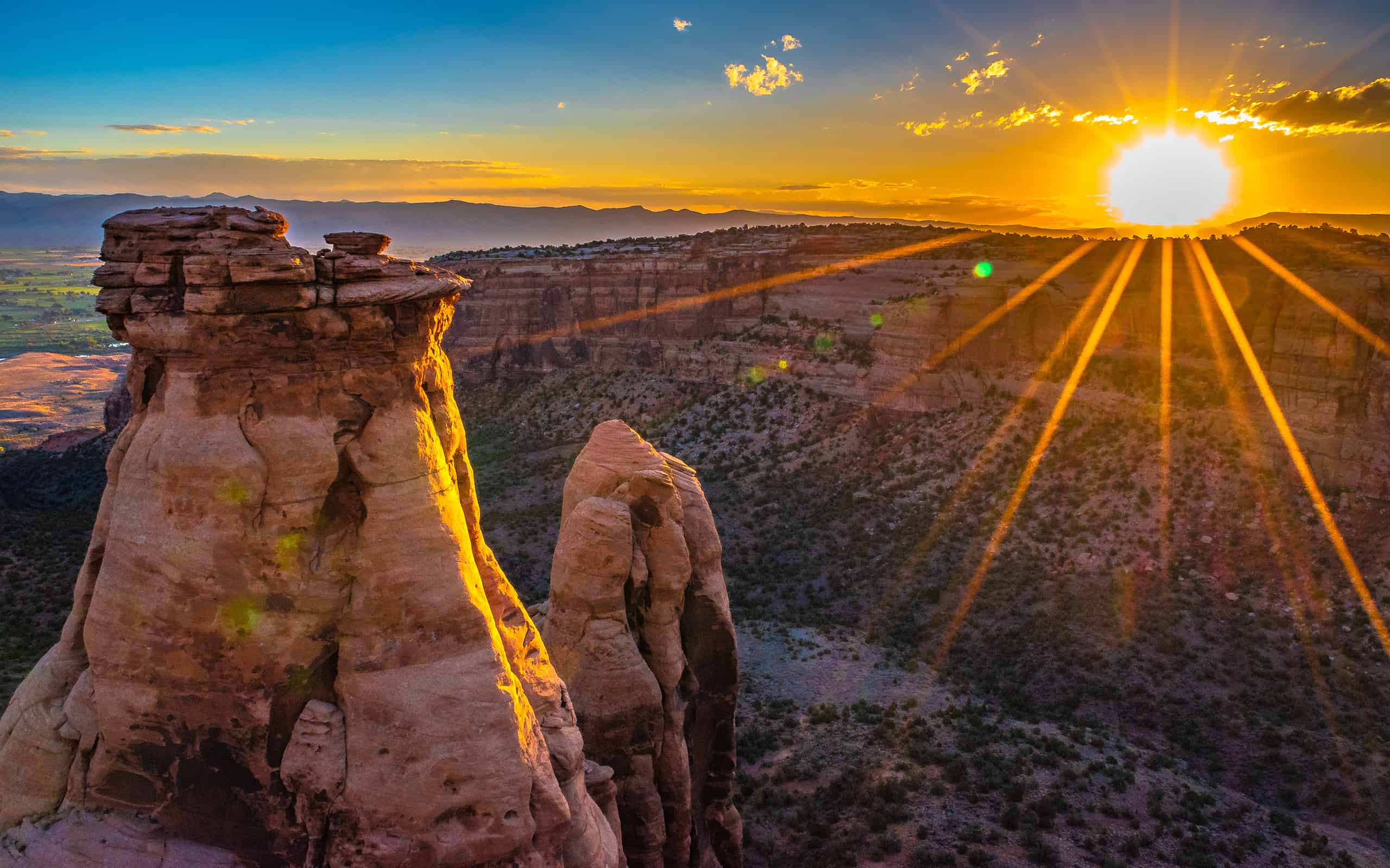Nestled in the rugged heart of the American West, Colorado stretches from the grand Rocky Mountains to the vast high plains. Woven with a rich history dating back thousands of years and peppered with the remains of westward expansion, including the famed Pike’s Peak Gold Rush. As September ushers in the first taste of fall in Colorado, the landscape transforms into the beautiful hues of reds, golds, and oranges. Here, we take a closer look at this iconic state’s September weather, its history of natural disasters, risks for future ones, and what activities and events are offered up during this transitional month.

The Garden of the Gods in Colorado Springs has a dinosaur named after it (having been discovered there), the
Theiophytalia kerri.©John Hoffman/Shutterstock.com
Colorado’s Climate and Weather Patterns
Complex Climate of Colorado Weather
Colorado is not merely a land of mountains and rivers, it’s a geographical mosaic that contributes to one of the most intricate climates in the United States. From its mountains to foothills, from the arid plains to desert lands, Colorado’s climate ebbs and flows with its diverse geography.
Eastern Plains
In the Eastern Plains you’ll find a semi-arid climate. Known for its hot summers and dry, cold winters, the region experiences cool clear nights and a significant diurnal temperature range. Here, Mother Nature often stages dramatic climatic events, from droughts and severe thunderstorms to major snowstorms.
Front Range Foothills
Among the foothills you’ll find a cornucopia of climates. The complex topography is a mix of microclimates ranging from semi-arid to alpine, humid subtropical to Mediterranean, and even the subarctic.
Colorado’s Extreme Weather
Colorado’s beauty is not without its perils. The state’s weather patterns are known to unleash extreme weather, from hailstorms to tornadoes. The eastern Plains are part of Tornado Alley and sees some of the most massive hailstorms in North America. Floods, too, are no strangers here.
Water Sources
Colorado’s mountains are not just breathtaking vistas. Rather, they are the wellspring of life, holding precious winter snowfalls that feed major rivers like the Colorado River Basin. This water courses its way through seven states and northern Mexico, nurturing lands and livelihoods.
Climate Change in Colorado
Climate change’s subtle but persistent hand is reshaping Colorado. The state has warmed one or two degrees Fahrenheit in the last century, sparking more frequent heatwaves, earlier snowmelt, and dwindling water in the mighty Colorado River. The future may hold less water, reduced crop yields, and increased wildfire risks, with southeastern Colorado’s residents facing health vulnerabilities.
Average Temperature in the Month
As autumn winds brush against Colorado’s stunning landscapes, temperatures in September gracefully dance to the rhythm of the changing seasons. Statewide the average high is 78 degrees and average low is 44 degrees. With a diverse landscape that feeds into numerous weather variations, Colorado offers something for everyone, whether basking in warmth or enjoying the fresh chill of the Rockies.
The daytime highs and lows vary greatly across the state. Here’s a snapshot:
| Location | Average High | Average Low |
|---|---|---|
| Aspen | 67 degrees | 40 degrees |
| Boulder | 79 degrees | 48 degrees |
| Colorado Springs | 77 degrees | 49 degrees |
| Denver | 80 degrees | 48 degrees |
| Grand Junction | 82 degrees | 53 degrees |
Historical Highs and Lows
La Junta’s fiery high of 108 degrees occurred on September 6, 2020. And Fraser’s chilling negative 2 degrees befell the town on September 30, 1959.

Denver, like other cities in Colorado, averages between 240 and 260 glorious sunny to partly sunny days.
©Virrage Images/Shutterstock.com
September Weather: Sunshine and Precipitation in Colorado
Sunshine in Colorado
With a name like the Centennial State, you’d expect something extraordinary from such a place. Well, Colorado’s weather and sunshine does not disappoint. Renowned for its beaming 300 sunny days a year, it’s a paradise for outdoor enthusiasts and winter sports fans.
Also, the state basks in high-altitude dry air, averaging a relatively low humidity of 33 percent.
City Sunshine
Alamosa reigns with an average of 285 sunlit days a year. Denver, Grand Junction, and Pueblo follow, with Pueblo’s 76 percent sunshine leading the way. Most cities average around 240 to 260 sunny or partly sunny days each year.
September Sunshine
In September, Denver’s daylight abides from 13 hours and 3 minutes at the start to 11 hours and 49 minutes by month’s end. It’s also important to keep in mind that twilight can run darker in the mountains based on which side you find yourself, east or west.
Rainfall and Other Precipitation
With an average precipitation of 16.5 inches, Colorado’s rainfall ranges from the high elevations’ 23 inches to the lower realms’ 8 inches. September can also see the first drifting snows.
Places like Ouray and Silverton in the southwest corner of the state receive highest average rainfall, while more central locations like Pueblo and Trinidad get the gentlest of drizzles.
Record Rainfall
Fort Carson recorded an intense 11.85 inches of rainfall on September 12, 2013.

Roadside signs like these are common throughout the state.
©marekuliasz/iStock via Getty Images
Natural Disasters or Extreme Weather Events in Colorado
A state’s developmental narrative is often greatly informed by its history of natural disasters and extreme weather events. Colorado is such a place, as it bears the scars of floods, avalanches, lightning, wildfires, tornadoes, hail, and earthquakes. These events weave a story of chaos and recovery, highlighting the state’s vulnerability and resilience.
Floods
The Big Thompson flood of 1976 and the 2013 Colorado Floods left indelible scars on the land and memory.
Droughts & Wildfires
Climate change is fueling droughts, with wildfires presenting a growing threat that leaves trails of destruction. Fire, both natural and human-made, dramatically shapes Colorado’s lands. The dry climate can turn into infernos, with devastating wildfires such as the Hayman, Waldo Canyon, and the Marshall Fire. The record-breaking Pine Gulch, Cameron Peak, and East Troublesome Fires of 2020 stand as somber reminders of nature’s raw power.
Impact and Significance of These Events on the Location
Human Lives
Natural disasters pose significant threats to human life and safety. Strong winds during fires have led to the death of a handful of people in Colorado, as well as severe injury. The South Canyon fire of 1994 killed 14 firefighters.
Economic Impact
The devastation leads to extensive damage and financial strain on communities. Many homes and other structures have been destroyed by wildfires.
Environmental Effects
Wildfires and other disasters scar the land and disrupt ecosystems. Effects range from pollution from particulate matter to infrastructure damage to habit loss for wildlife.
Historical Weather Events or Anomalies
Echoes of Hurricanes
Despite not making landfall in the state, Hurricanes Javier and Rosa created weather systems that reached Colorado despite its distance from coastal regions. Both occurred during the month of September.
Earthquake of 2011
A record-breaking 5.3 magnitude tremor, this earthquake was the largest to hit the state in over a hundred years.
Other Notable Historic Events
The 1884 Woodstock Avalanche
1913 Denver Blizzard
The Great Flood of 1921 in Pueblo, a tragic tale of destruction and loss.
The Hayman Fire in 2002, the largest in the state’s history until the Pine Gulch Fire of 2020, was started by a forestry technician who was later indicted on four counts of felony arson.
Wildfires and Lightning Strikes in Colorado
Wildfires in Colorado have not only asserted nature’s raw power but have also highlighted the state’s vulnerability and the essential role of prevention and response. Understanding the risks, causes, and impacts of these wildfires is vital, as shown by the Pine Gulch Fire.
The Pine Gulch Fire of 2020
Ignition and Growth
The Pine Gulch Fire, ignited by a lightning strike, quickly grew to become the largest wildfire in Colorado’s history, surpassing even the 2002 Hayman Fire. Threatening both private and public lands, the fire’s rapid spread was fueled by hot weather, steep terrain, and drought-stricken vegetation.
Threats and Impacts
This wildfire threatened gas and oil drilling infrastructure, resulting in evacuations, road closures, and impacts on air quality in several counties. The fire also caused minor injuries to firefighters and affected recreation, transportation, and energy sectors in the area.
Containment and Resolution
Through the tireless efforts of fire crews and containment measures, the Pine Gulch Fire was eventually brought under control. After almost seven weeks, all evacuation orders were lifted, and the fire was declared 100 percent contained on September 23, having burned a significant total area of land.
The Pine Gulch Fire’s profound and lasting effects on infrastructure, economy, and environment underscore the broader economic and environmental impact of wildfires in the state. It serves as a reminder of the importance of preparedness, awareness, and respect for the potentially destructive beauty of nature’s forces.

Combined with the state’s semi arid climate, historical drought, and high altitude, lightning is a potent danger.
©sabinamoscovici/Shutterstock.com
Lightning Strikes: A Continuing Weather Risk in Colorado
National Ranking Colorado ranks 4th in the nation for deaths due to lightning strikes, emphasizing the significance of safety measures.
Awareness and Precaution
Understanding the connection between lightning and wildfires, as seen in the Pine Gulch Fire, reinforces the need for vigilance and safety practices.
Recreation and Lightning Safety
Shelter during storms, awareness of risks, adherence to local authorities’ recommendations.
High elevation comes with heightened risks of lightning. Whether hiking in places like Rocky Mountain National Park or mountain biking atop the plateaus of Golden, you want to be wary of approaching storms. Lightning can travel around 10 miles from the edges of thunderstorms.
Activities and Festivals in Colorado in September
September in Colorado heralds a season of transformation, adventure, and celebration. The state’s many charms provide a golden opportunity to explore its rich landscapes, from ski towns and small towns to the vibrant city of Denver.
Exploring Colorado’s Towns and Cities
Visit Ski Towns
As mountains begin to don their snowy crowns, this picturesque time invites exploration of Colorado’s famed ski towns.
Explore Small Towns
Wander through the unique and colorful small towns, such as Silverton, Estes Park, and Paonia. Each one tells its own distinctive story.
Denver’s Attractions
Dive into urban exploration with Denver’s myriad cultural sites and attractions, offering a cosmopolitan twist to your journey. Flower lovers will want to check out the Denver Botanical Garden. Animal lovers can enjoy the Denver Zoo. And art lovers have a haven in the Denver Art Museum. Also, the redesigned Union Station is worth a visit.

The redesigned hypermodern train platforms of Denver’s Union Station contrasts nicely with the main building’s 19th century charm.
©Arina P Habich/Shutterstock.com
Activities, Festivals, and Outdoor Experiences
Take In the Fall Colors
September’s onset of fall paints Colorado with stunning hues. Explore scenic drives and hiking trails to immerse yourself in this breathtaking palette.
Apple Picking and Cider Tasting
Celebrate the apple season by picking fresh produce and savoring local ciders.
Pueblo vs. Hatch Chiles Festival
Join the flavorful debate at the Chile & Frijoles Fest in Pueblo, a feast for the senses.
Experience the Elk Rut
Witness the spectacle (from a safe distance) of the elk mating season and the unique Elk Fest in Estes Park.
Embrace the Harvest Season
From pumpkin patches to corn mazes and farmers’ markets, September is a time to celebrate the land’s bounty.
Explore Meow Wolf Denver
Engage with art at this immersive exhibition, a playground for the imagination.
Celebrate Beer Festivals
Raise a toast to Colorado’s vibrant and varied beer culture at Oktoberfest and the Great American Beer Festival.
Relax in Hot Springs
Soak in the serenity of Colorado’s hot springs, a soothing embrace for the autumn chill.
Cultural Celebrations
Partake in festivals that celebrate Celtic and Hispanic heritage, embracing the state’s diverse cultural fabric.
Outdoor Activities
Enjoy hiking, camping, and the stunning natural beauty in locations like Grand Junction, Garden of the Gods in Colorado Springs, and Telluride.
Conclusion
September in Colorado is marked by lovely weather, with cooler temperatures and the unfolding beauty of autumn scenery. This time of transformation is a great time to revel in nature, from high-altitude hikes to the spectral vibrancy of leaves and wildlife viewing. Whether you’re drawn to snowy peaks, busy urban life, or the rich cultural experiences, September in Colorado contains unique charms and endless possibilities.
Thank you for reading! Have some feedback for us? Contact the AZ Animals editorial team.








